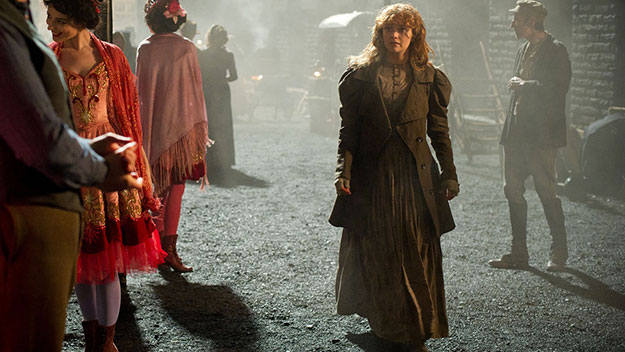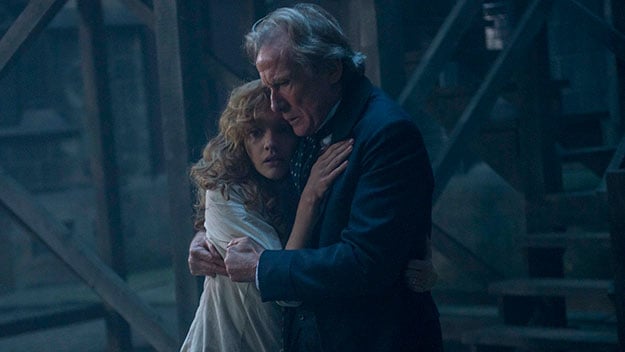Deep Focus: The Limehouse Golem

Set in 1880 London, Juan Carlos Medina’s The Limehouse Golem, an eccentric murder mystery ingeniously adapted from a first-rate Peter Ackroyd novel, cuts like a straight-edge razor between the traumatic life of a rags-to-riches music-hall star, Little Lizzie (Olivia Cooke), and the gaudy career of a serial killer. This monster murders every type of citizen in an impoverished East End neighborhood: whores, a scholar, a family living above their second-hand-clothing shop. The newspapers dub this maniac The Limehouse Golem. Why? Because he severs the phallus of a Jewish intellectual and leaves it on a book open to a chapter on the mythic Golem, the clay homunculus that a rabbi brings to life and then must struggle to control. The killer embraces the nickname.
The killer’s ghastly mutilations and East End location bring to mind Jack the Ripper, who would slash his way to infamy just eight years later. And the attempt of Scotland Yard’s Inspector Kildare (Bill Nighy) to apprehend the villain prefigures Sherlock Holmes, who first appeared in 1887. It’s a treat to see a ripping yarn set in this film’s impressionistic evocation of a vital, chaotic city. The filmmakers bring the pea-soup fog of 19th-century London to an aesthetic boil that should be savored. Along with cinematographer Simon Dennis and production designer Grant Montgomery, Medina envisions how the otherworldly greens and browns spawned by industrial pollution combine with lowering clouds and gaslight to permeate the whole metropolitan area with a crepuscular aura. The mist-filled cityscapes prove variously eye-popping and eerie at different times of night or day. To go from these mean streets into the music hall is to enter a bawdy, giddy working-class Olympus. Red, white, and pink roses spill over huge baskets in the back of the stage. Under the theater’s bright lights, gilded columns register as solid gold, and a haughty acrobat in a jade trapeze suit comes off as a goddess.
The moviemakers have more on their minds than mounting a Ripper-like Sherlockian detective case with an unusual blend of grit and lushness. Screenwriter Jane Goldman could have gone in several directions with her adaptation. (Ackroyd’s title was Dan Leno and the Limehouse Golem; in America the novel appeared as The Trial of Elizabeth Cree: A Novel of the Limehouse Murders.) She intelligently and incisively shapes Ackroyd’s material to dramatize the roots of the theater of gruesome horror known as Grand Guignol. We see two sensational stories converge in the music hall and cheap newspapers. Lizzie goes to trial, accused of poisoning her husband, John Cree (Sam Reid), just when the penny press reaches fever pitch over the Limehouse murders. We learn that the Golem conceives and executes slaughters for the delectation of the public. The killer’s relation to the fans can seem ambivalent. On one crime scene the Golem scrawls, in Latin, “He who observes spills no less blood than he who inflicts the blow.” Still, the Golem revels in being noticed and feeding public appetites for sensation. Not all of this film’s predecessors, though, are tabloid-y or pulpy. In condescension, wit, and pride, the Golem resembles a garish version of Lacenaire, the killer-playwright in Children of Paradise.

In a godless universe the Golem strives to achieve eternal fame. He hopes to be immortalized in the manner of John Williams, the serial killer who inspired Thomas De Quincey’s cheeky 1827 essay, “On Murder Considered as One of the Fine Arts.” Too bad Grand Guignol is all he gets. In the movie’s inspired framing device, music-hall phenomenon Dan Leno (Douglas Booth), Lizzie’s mentor and best friend, stages his own re-creation of her trial with upsetting results. It’s as if the film were marking the point when the line between real and stage violence blurred. It reminds me of what the final director of the actual Theatre du Grand Guignol told Time when he closed the venue in 1962: “We could never equal Buchenwald.”
The murders are as grisly as any horror movie’s, but Medina and Goldman eschew gross-out or “Gotcha!” moments. The shock shoots out from the jolting contrast between the escalating atrocities and the Golem’s florid intellectualism. The Golem pens a confessional diary directly over the pages of the De Quincey essay at the British Museum’s Reading Room. The butcher clearly wants someone to discover his journal, written in a bold, idiosyncratic hand. Kildare quickly obliges. He proceeds to examine the Golem’s fellow reading-room habitués—a group that includes Karl Marx (Henry Goodman), George Gissing (Morgan Watkins), and music-hall phenomenon Leno. Kildare doesn’t merely interrogate them. As Kildare reads from the diary, each suspect must transcribe, in his own handwriting, the Golem’s account of a murder. As they do, Medina puts the crimes on screen. The filmmakers use this device to build dread while fleshing out their analysis of London as an out-of-control boomtown. A nun ministering to the city’s poor defends Karl Marx as their champion. Marx, in turn, views the Golem as a scourge on urban scapegoats—whores and Jews.
In one key moment, Kildare lectures Gissing, who married an alcoholic prostitute, about the spiritual hubris of men “who feign generosity when what they really seek is congratulation. Men who play God by saving lives—is it really so different, I wonder, from playing God by taking lives?” By then, Kildare has convinced himself of a connection between his Golem investigation and the trial of Lizzie Cree. And his stalwart assistant, Constable Flood (Daniel Mays), fears Kildare’s obsession with saving her from the noose.

The bond between Kildare and Lizzie becomes the film’s emotional prism, and the Nighy-Cooke acting duet its artistic jewel. These two convey flashes of depth and authenticity with the sparest means. It’s a lucky talent to have in a sardonic drama that pivots on people masking their true selves in theater and society.
Alan Rickman, originally cast as Kildare, died early in 2016. Not surprisingly, this atypical part requires Nighy to stretch beyond his usual tour de force of dithering and indirection. Kildare thinks he could be Lizzie’s savior. We want him to succeed for his own sake, too. We hear that he’s been passed over for promotion because he’s not “the marrying kind.” (In the words of Monty Python, “nudge nudge, wink wink.”) It’s a prize opportunity for Nighy to play a hero who never leaves mission mode, and he does it in his own instinctive style. He turns Kildare into the British equivalent of the strong silent type. He transforms politeness and restraint into prime investigative tools. Even his quiet can serve as a prod. With Cooke’s Lizzie he’s punctilious, but he lets his emotions play all over his face. He delivers a portrait of obdurate strength and sensitivity, shading scenes with a flicker of an eyelid or an extra watt of brightness in the eye itself.
If Nighy anchors the movie, Cooke does a marvelous job of tugging at that anchor. She pulls the movie toward deeply felt extremes of vulnerability, awe, bravado, and ambition without snapping its tether. She has the wisdom to play Lizzie, a bastard child, as if the abuse of her guilt-ridden, God-fearing mother; the hard, scarring work of mending sails; and the assaults she suffers from her male customers on the docks have sharpened her humor and toughened her hide. She won’t be anybody’s victim, not even her mom’s. But what have these traumas done to her soul? Cooke nails every spot on the emotional spectrum of a role that has extraordinary range. When the magic of the theater strikes her dumb and Leno’s drag act sweeps her up in its invention and exuberance, she displays the plangent wonder of a Dorothy or Lillian Gish. But when Lizzie determines to be frank and proud in the courtroom, she evokes the fierce rigor of Meryl Streep in A Cry in the Dark, the one movie in which Streep left all artifice behind.

Cooke was unsentimental and affecting in the quirky teen relationship film Me and Earl and the Dying Girl (2015). In The Limehouse Golem she’s at her best when Lizzie galvanizes the music hall. True, the music hall scenes exude high spirits from the start. And kudos to the entire company—uncanny Eddie Marsan as the troupe’s alarmingly sly comic-manager, María Valverde as its trapeze artist and potential femme fatale, Graham Hughes as its funky and often nasty little person, and Booth as the drag star whose generosity and energy burst the bounds of the stage. Still, they all hook our attention because Medina has filtered them through Cooke’s affecting gaze. Lizzie gets how Leno’s cross-dressing specialty numbers play off the audience’s shared knowledge of domestic cruelty. Booth tears into one of Leno’s real-life hits, with lines like “He knocked corners off me this morning.” Leno’s salty, bellicose drag housewife shakes an iron in one hand and a kitchen knife in the other, belting out, “But I’m waiting for him tonight.” Lizzie drinks it in, beaming from ear to ear.
Cooke comes into her own when in true 42nd Street fashion Lizzie takes the stage to fill an unexpected gap in the playbill. She pulls off a triumph of innuendo with another actual music-hall classic, “What Did She Know About Railways?” She puts a spin on her own grinning innocence, relishing the groaning double entendres like “She’d never had her ticket punched before.” As a physical comic she performs unexpected pelvic tilts with dazzling, spontaneous panache. Lizzie’s delight at being in the spotlight freshens up even the earthiest comedy. But Cooke’s honesty as an actress keeps us wondering where all this energy really comes from—and where it will end up going.
In the theater, the best way to prove you’re a headliner is to follow a headliner—or play one. A lot of people get knocked off in The Limehouse Golem. But in the role of an irresistible newcomer, Olivia Cooke is the one who kills it. With any luck, a star is born.
Michael Sragow is a contributing editor to Film Comment and writes its Deep Focus column. He is a member of the National Society of Film Critics and the Los Angeles Film Critics Association. He also curates “The Moviegoer” at the Library of America website.







